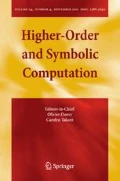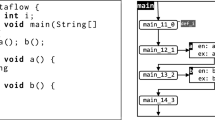Abstract
This article presents the octagon abstract domain, a relational numerical abstract domain for static analysis by abstract interpretation. It allows representing conjunctions of constraints of the form ± X ± Y ≤ c where X and Y range among program variables and c is a constant in ℤ, ℚ, or ℝ automatically inferred. Abstract elements are represented using modified Difference Bound Matrices and we use a normalization algorithm loosely based on the shortest-path closure to compute canonical representations and construct best-precision abstract transfer functions. We achieve a quadratic memory cost per abstract element and a cubic worst-case time cost per abstract operation, with respect to the number of program variables.
In terms of cost and precision, our domain is in between the well-known fast but imprecise interval domain and the costly polyhedron domain. We show that it is precise enough to treat interesting examples requiring relational invariants, and hence, out of the reach of the interval domain. We also present a packing strategy that allows scaling our domain up to large programs by tuning the amount of relationality. The octagon domain was incorporated into the ASTRÉE industrial-strength static analyzer and was key in proving the absence of run-time errors in large critical embedded flight control software for Airbus planes.
Similar content being viewed by others
References
1. ACI Sécurité & Informatique. Analyse de PROgrammes Numériques. http://www.cri.ensmp.fr/apron/
2. Airbus. http://www.airbus.com/
3. Astrée. Analyse Statique de logiciels Temps-Réel embarqués (static analysis of critical real-time embedded software) analyzer page. http://www.astree.ens.fr/
4. Bagnara, R.: Data-Flow Analysis for Constraint Logic-Based Languages. PhD thesis, Dipartimento di Informatica, Universitá di Pisa, Corso Italia 40, I-56125 Pisa, Italy (1997)
5. Bagnara, R., Hill, P.M., Mazzi, E., Zaffanella, E.: Widening operators for weakly-relational numeric abstractions. Quaderno 399, Dipartimento di Matematica, Universitá di Parma, Italy (2005)
6. Balasundaram, V., Kennedy, K.: A technique for summarizing data access and its use in parallelism enhancing transformations. In: ACM PLDI′;89, ACM Press, pp. 41–53. (1989)
7. Bellman, R.: On a routing problem. In: Quarterly of Applied Mathematics, vol. 16, pp. 87–90 (1958)
8. Blanchet, B., Cousot, P., Cousot, R., Feret, J., Mauborgne, L., A., Miné, Monniaux, D., Rival, X.: Design and implementation of a special-purpose static program analyzer for safety-critical real-time embedded software, invited chapter. In: The Essence of Computation: Complexity, Analysis, Transformation. Essays Dedicated to Neil D. Jones, LNCS, Springer, pp. 85–108. (2002)
9. Blanchet, B., Cousot, P., Cousot, R., Feret, J., Mauborgne, L., Miné, A., Monniaux, D., Rival, X.: A static analyzer for large safety-critical software. In: ACM PLDI′;03, vol. 548030, pp. 196–207, ACM Press, (2003)
10. Bourdoncle, F.: Abstract interpretation by dynamic partitioning. Journal of Functional Programming 2(4), 407–423 (1992)
11. Bourdoncle, F.: Abstract debugging of higher-order imperative languages. In: ACM PLDI′;93, pp. 46–55. ACM Press, (1993)
12. Clarisó, R., Cortadella, J.: The octahedron abstract domain. In: SAS′;04, vol. 3148 of LNCS, pp. 312–327. Springer (2004)
13. Colón, M.A., Sipma, H.B.: Synthesis of linear ranking functions. In: TACAS′;01, vol. 2031 of LNCS, pp. 67–81 (2001)
14. Cormen, T., Leiserson, C., Rivest, R.: Introduction to Algorithms. The MIT Press (1990)
15. Cousot, P.: The calculational design of a generic abstract interpreter. In: Calculational System Design, NATO ASI Series F. IOS Press (1999)
16. Cousot, P.: Verification by abstract interpretation. In: Proc. Int. Symp. on Verification—Theory & Practice—Honoring Zohar Manna’s 64th Birthday, vol. 2772, pp. 243–268. Springer (2003)
17. Cousot, P., Cousot, R.: Static determination of dynamic properties of programs. In ISOP′;76, pp. 106–130. Dunod, Paris, France (1976)
18. Cousot, P., Cousot, R.: Abstract interpretation: A unified lattice model for static analysis of programs by construction or approximation of fixpoints. In: ACM POPL′;77, pp. 238–252. ACM Press (1977)
19. Cousot, P., Cousot, R.: Abstract interpretation and application to logic programs. Journal of Logic Programming 13(2–3), 103–179 (1992)
20. Cousot, P., Cousot, R.: Abstract interpretation frameworks. Journal of Logic and Computation 2(4), 511–547 (1992)
21. Cousot, P., Cousot, R.: Comparing the Galois connection and widening/narrowing approaches to abstract interpretation, invited paper. In: PLILP′;92, LNCS, pp. 269–295. Springer (1992)
22. Cousot, P., Halbwachs, N.: Automatic discovery of linear restraints among variables of a program. In: ACM POPL′;78, pp. 84–97. ACM Press (1978)
23. Deutsch, A. Interprocedural may-alias analysis for pointers: Beyond k-limiting. In: ACM PLDI′;94, pp. 230–241. ACM Press (1994)
24. Dill, D.L.: Timing assumptions and verification of finite-state concurrent systems. In: Proc. International Workshop on Automatic verification Methods for Finite State Systems vol. 407 of LNCS, pp. 197–212, Springer
25. Dor, N., Rodeh, M., Sagiv, M.: Cleanness checking of string manipulations in C programs via integer analysis. In: SAS′;01, vol. 2126 of LNCS. Springer (2001)
26. Feret, J.: Abstract interpretation of mobile systems. JLAP (2004)
27. Feret, J.: Static analysis of digital filters. In: ESOP′;04, vol. 2986 of LNCS. Springer (2004)
28. Feret, J.: The arithmetic-geometric progression abstract domain. In: VMCAI′;05, vol. 3385 of LNCS. Springer (2005)
29. Granger, P.: Static analysis of arithmetical congruences. International Journal of Computer Mathematics, 30, 165–190 (1989)
30. Halbwachs, N.: Détermination automatique de relations linéaires vérifiées par les variables d’un programme. PhD thesis, Université scientifique et medicale de Grenoble, France (1979)
31. Handjieva, M., Tzolovski, S.: Refining static analyses by trace-based partitioning using control flow. In: SAS′;98, vol. 1503 of LNCS, pp. 200–214 (1998)
32. Harvey, W., Stuckey, P.: A unit two variable per inequality integer constraint solver for constraint logic programming. In: ACSC′;97, vol. 19, pp. 102–111 (1997).
33. Jaffar, J., Maher, M., Stuckey, P., Yap, H.: Beyond finite domains. In: PPCP′;94, vol. 874 of LNCS, pp. 86–94. Springer (1994)
34. Jeannet, B.: Partitionnement dynamique dans l’analyse de relations Linéaires et application á la Vérification de programmes synchrones. PhD thesis, Institut National Polytechnique de Grenoble, France (2000)
35. Karr, M.: Affine relationships among variables of a program. Acta Informatica, pp. 133–151 (1976)
36. Larsen, K., Weise, C., Yi, W., Pearson, J.: Clock difference diagrams. Nordic Journal of Computing, 6(3), 271–298 (1999)
37. Lions, J.L.: ARIANE 5, flight 501 failure, report by the Inquiry Board (1996)
38. Mauborgne, L.: ASTRÉE: Verification of absence of run-time error. In: Building the Information Society (18th IFIP World Computer Congress), vol. 156, pp. 385–392. Springer (2004)
39. Mauborgne, L., Rival, X.: Trace partitioning in abstract interpretation based static analyzers. In ESOP′;05, vol. 3444 of LNCS, pp. 5–20. Springer (2005)
40. Measche, M., Berthomieu, B.: Time Petri-nets for analyzing and verifying time dependent communication protocols. Protocol Specification, Testing and Verification III, pp. 161–172 (1983)
41. Miné, A.: The octagon abstract domain library. http://www.di.ens.fr/mine/oct/
42. Miné, A.: On-line octagon abstract domain sample analyzer. http://cgi.di.ens.fr/cgi-bin/mine/octanalhtml/octanalweb/
43. Miné, A.: A new numerical abstract domain based on difference-bound matrices. In: PADO II, vol. 2053 of LNCS, pp. 155–172. Springer (2001)
44. Miné, A.: The octagon abstract domain. In: AST 2001 in WCRE 2001, IEEE, pp. 310–319. IEEE CS Press (2001)
45. Miné, A.: Relational abstract domains for the detection of floating-point run-time errors. In: ESOP′;04, vol. 2986 of LNCS, pp. 3–17. Springer (2004)
46. Miné, A.: Weakly Relational Numerical Abstract Domains. PhD thesis, École Polytechnique, Palaiseau, France (2004). http://www.di.ens.fr/mine/these/
47. Møller, J., Lichtenberg, J., Andersen, H.R., Hulgaard, H.: Difference decision diagrams. In: CSL′;99, vol. 1683 of LNCS, pp. 111–125. Springer (1999)
48. Moore, R.E.: Interval Analysis. Prentice Hall (1966)
49. OCaml.: The objective Caml system. http://paulliac.inria.fr/ocaml
50. Rugina, R.: Quantitative shape analysis. In: SAS′;04, vol. 3148 of LNCS, pp. 228–245. Springer (2004)
51. Shaham, R., Kolodner, E.K., Sagiv, M.: Automatic removal of array memory leaks in java. In: CC′;00, LNCS, pp. 50–66. Springer (2000)
52. Simon, A., King, A., Howe, J.: Two variables per linear inequality as an abstract domain. In: LOPSTR′;02, vol. 2664 of LNCS, pp. 71–89. Springer (2002)
53. Venet, A.: Nonuniform alias analysis of recursive data structures and arrays. In: SAS′;02, vol. 2477 of LNCS, pp. 36–51. Springer (2002)
54. Yovine, S.: Model-checking timed automata. In: Embedded Systems, vol. 1494 of LNCS. Springer (1998)
Author information
Authors and Affiliations
Corresponding author
Additional information
This paper is the journal version of an earlier conference paper [44] sharing this title. However, the present version, extracted from the author’s PhD [46] is extended in many ways and enriched with new experimental results.
Partially supported by the exploratory project ASTRÉE of the Réseau National de recherche et d’innovation en Technologies Logicielles (RNTL).
Rights and permissions
About this article
Cite this article
Miné, A. The octagon abstract domain. Higher-Order Symb Comput 19, 31–100 (2006). https://doi.org/10.1007/s10990-006-8609-1
Issue Date:
DOI: https://doi.org/10.1007/s10990-006-8609-1




